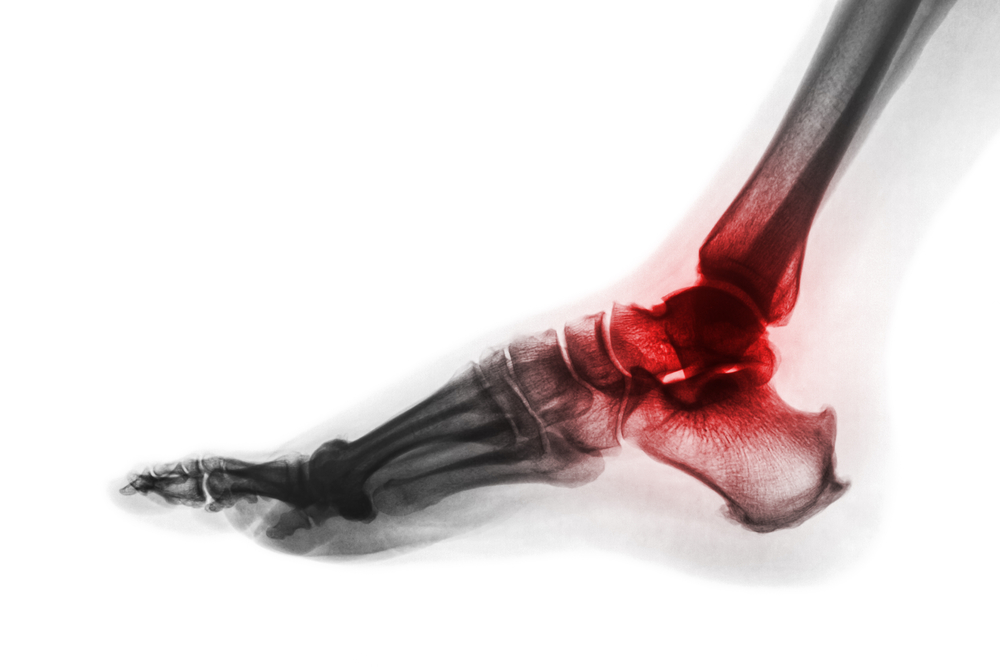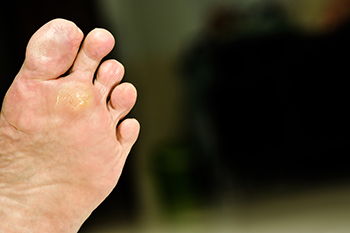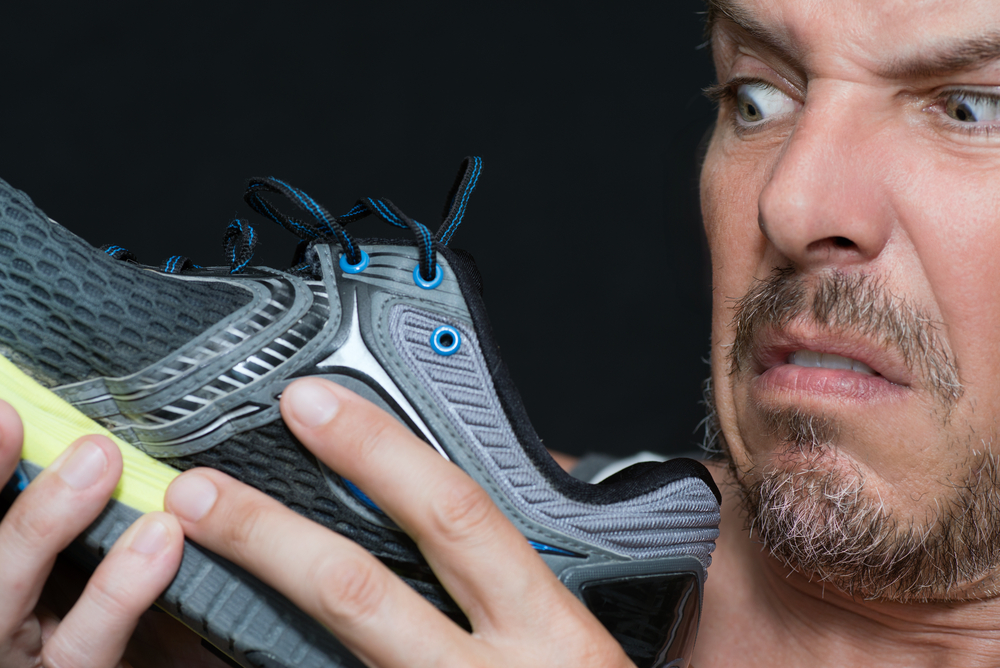 Rheumatoid arthritis can be a debilitating disease where a joint's lining (synovium) is attacked by the body’s immune system. This causes the synovium to become inflamed, which damages the surrounding tissues and ligaments. In time, this may dislocate toe joints and cause deformities such as bunions and hammertoes. Along with toe joints, rheumatoid arthritis can also occur in the ankle joint, the tarsometatarsal joints in the midfoot, and the hindfoot (heel area). While rheumatoid arthritis has no cure, a podiatrist can help treat its symptoms which, if left untreated, may inhibit a person’s ability to lead a normal life. Your podiatrist may prescribe special shoes, braces, and/or create custom orthotics to help restore functionality to the feet and relieve pain. Icing, gentle exercises, and physical therapy may also help relieve symptoms, as can corticosteroid injections. Make an appointment with a podiatrist today to begin treatment for your painful rheumatoid arthritis symptoms.
Rheumatoid arthritis can be a debilitating disease where a joint's lining (synovium) is attacked by the body’s immune system. This causes the synovium to become inflamed, which damages the surrounding tissues and ligaments. In time, this may dislocate toe joints and cause deformities such as bunions and hammertoes. Along with toe joints, rheumatoid arthritis can also occur in the ankle joint, the tarsometatarsal joints in the midfoot, and the hindfoot (heel area). While rheumatoid arthritis has no cure, a podiatrist can help treat its symptoms which, if left untreated, may inhibit a person’s ability to lead a normal life. Your podiatrist may prescribe special shoes, braces, and/or create custom orthotics to help restore functionality to the feet and relieve pain. Icing, gentle exercises, and physical therapy may also help relieve symptoms, as can corticosteroid injections. Make an appointment with a podiatrist today to begin treatment for your painful rheumatoid arthritis symptoms.
Because RA affects more than just your joints, it is important to seek early diagnosis from your podiatrist if you feel like the pain in your feet might be caused by RA. For more information, contact Brent Harwood, DPM from Southeast Podiatry. Our doctor will assist you with all of your podiatric concerns.
What Is Rheumatoid Arthritis?
Rheumatoid Arthritis (RA) is an autoimmune disorder in which the body’s own immune system attacks the membranes surrounding the joints. Inflammation of the lining and eventually the destruction of the joint’s cartilage and bone occur, causing severe pain and immobility.
Rheumatoid Arthritis of the Feet
Although RA usually attacks multiple bones and joints throughout the entire body, almost 90 percent of cases result in pain in the foot or ankle area.
Symptoms
Diagnosis
Quick diagnosis of RA in the feet is important so that the podiatrist can treat the area effectively. Your doctor will ask you about your medical history, occupation, and lifestyle to determine the origin of the condition. Rheumatoid Factor tests help to determine if someone is affected by the disease.
If you have any questions please feel free to contact our our offices located in Fairhope, Brewton, and Atmore, AL. We offer the newest diagnostic and treatment technologies for all your podiatric needs.
Read more about Rheumatoid Arthritis
 Research has shown that plantar warts affect approximately ten percent of the population. They are warts that develop on the sole of the foot, and grow inward as a result of the weight the feet endure on a daily basis. They are generally caused by the human papilloma virus (HPV), and can enter the body through small cuts in the skin on the feet. They are prone to developing on the ball and heel of the foot, and are considered to be hyperkeratotic eruptions. Plantar warts can cause severe pain and discomfort, and aggressive treatment may be necessary to relieve the pain while walking. Some patients have to alter their style of walking if they have a plantar wart, and their posture may be affected. If you have a wart on the bottom of your foot, please seek the counsel of a podiatrist who can effectively treat this condition.
Research has shown that plantar warts affect approximately ten percent of the population. They are warts that develop on the sole of the foot, and grow inward as a result of the weight the feet endure on a daily basis. They are generally caused by the human papilloma virus (HPV), and can enter the body through small cuts in the skin on the feet. They are prone to developing on the ball and heel of the foot, and are considered to be hyperkeratotic eruptions. Plantar warts can cause severe pain and discomfort, and aggressive treatment may be necessary to relieve the pain while walking. Some patients have to alter their style of walking if they have a plantar wart, and their posture may be affected. If you have a wart on the bottom of your foot, please seek the counsel of a podiatrist who can effectively treat this condition.
Plantar warts can be very uncomfortable. If you need your feet checked, contact Brent Harwood, DPM from Southeast Podiatry. Our doctor will assist you with all of your podiatric needs.
About Plantar Warts
Plantar warts are the result of HPV, or human papillomavirus, getting into open wounds on the feet. They are mostly found on the heels or balls of the feet.
While plantar warts are generally harmless, those experiencing excessive pain or those suffering from diabetes or a compromised immune system require immediate medical care. Plantar warts are easily diagnosed, usually through scraping off a bit of rough skin or by getting a biopsy.
Symptoms
Treatment
To help prevent developing plantar warts, avoid walking barefoot over abrasive surfaces that can cause cuts or wounds for HPV to get into. Avoiding direct contact with other warts, as well as not picking or rubbing existing warts, can help prevent the further spread of plantar warts. However, if you think you have developed plantar warts, speak to your podiatrist. He or she can diagnose the warts on your feet and recommend the appropriate treatment options.
If you have any questions please feel free to contact our our offices located in Fairhope, Brewton, and Atmore, AL. We offer the newest diagnostic and treatment technologies for all your podiatric needs.
 It’s not about the looks or the status, it’s about the fit. When in doubt, experts recommend that when shopping for running shoes to put fit over fashion, brand, or price. Shoes that are too tight can cause blisters, while shoes that are too wide can hurt your toes. Shoes that fit poorly can cause tendonitis, pinched nerves, heel pain, and stress fractures. Signs that your shoes don’t fit properly include heel slippage, numbness on the top of the feet, and bruising on the toes. The best way to prevent these from occurring is to measure your feet while also wearing the socks you will use as you run. Check your foot measurements periodically, as foot size can change if you gain or lose weight. A rule of thumb is to have at least a half-inch of room between your toes and the end of the shoe. Running shoes usually run about half a size larger than street shoes, to allow for the feet to expand as you run. Try on several types of shoes before making a decision. If you need guidance on the best running shoe for you, please consult a podiatrist.
It’s not about the looks or the status, it’s about the fit. When in doubt, experts recommend that when shopping for running shoes to put fit over fashion, brand, or price. Shoes that are too tight can cause blisters, while shoes that are too wide can hurt your toes. Shoes that fit poorly can cause tendonitis, pinched nerves, heel pain, and stress fractures. Signs that your shoes don’t fit properly include heel slippage, numbness on the top of the feet, and bruising on the toes. The best way to prevent these from occurring is to measure your feet while also wearing the socks you will use as you run. Check your foot measurements periodically, as foot size can change if you gain or lose weight. A rule of thumb is to have at least a half-inch of room between your toes and the end of the shoe. Running shoes usually run about half a size larger than street shoes, to allow for the feet to expand as you run. Try on several types of shoes before making a decision. If you need guidance on the best running shoe for you, please consult a podiatrist.
You should always make sure your running shoes fit properly in order to avoid injury. For more information, contact Brent Harwood, DPM from Southeast Podiatry. Our doctorcan provide the care you need to keep you pain-free and on your feet.
Choosing the Right Running Shoe for Your Foot Type
Improper shoe sizing can cause a myriad of problems for your feet. Shoes that don’t fit you properly can lead to muscular imbalances in your body, which can result in foot, knee, and hip injuries.
Tips for Finding the Right Running Shoe
If you have any questions please feel free to contact our our offices located in Fairhope, Brewton, and Atmore, AL. We offer the newest diagnostic and treatment technologies for all your podiatric needs.
Many people have stubbed their toe by hitting it or dropping something heavy on it, felt pain, and wondered if it was broken. It might be a sprain but it is important to know if the toe is broken because if left untreated, a broken toe can lead to problems in movement and later down the road, potential for osteoarthritis or nerve damage. If you hear a bone break, feel intense pain and the toe swells, see discoloration, or have trouble putting weight on it, the toe might be broken. With a bad break, there can be a dislocation and the toe will look like it is at an odd angle. With a sprained toe, all the same symptoms may be present but the toe should not look dislocated and it should feel better sooner than a broken toe. Also, with a break, the pain is often felt right where the fracture has taken place versus being more generalized around the toe with a sprain. Prevent such injuries to your toes by refraining from going barefoot, especially in the dark and in unfamiliar areas. If symptoms do not get better in a few days, it is suggested to see a podiatrist who will take X-rays and provide you with a definitive diagnosis and appropriate treatment.
Broken toes may cause a lot of pain and should be treated as soon as possible. If you have any concerns about your feet, contact Brent Harwood, DPM from Southeast Podiatry. Our doctor will treat your foot concerns.
What Is a Broken Toe?
A broken toe occurs when one or more of the toe bones of the foot are broken after an injury. Injuries such as stubbing your toe or dropping a heavy object on it may cause a toe fracture.
Symptoms of a Broken Toe
Although the injured toe should be monitored daily, it is especially important to have a podiatrist look at your toe if you have severe symptoms. Some of these symptoms include worsening or new pain that is not relieved with medication, sores, redness, or open wounds near the toe.
If you have any questions please feel free to contact our office located in Fairhope, Brewton, and Atmore, AL. We offer the newest diagnostic and treatment technologies for all your podiatric needs.
 People who have feet that sweat excessively may have a condition that is known as plantar hyperhidrosis. It may be the result of a neurological or endocrine disorder and can be quite uncomfortable. There are several treatment options, and this can depend on the severity of this ailment. Surgery may be a viable option for successfully removing the sweat glands. Patients who are afflicted with this condition often keep an extra pair of shoes and socks close by. It can be professionally and socially disabling, and many patients who have this condition are often embarrassed. If you think you may have hyperhidrosis, it is suggested that you schedule an appointment with a podiatrist who can offer you the correct treatment solutions.
People who have feet that sweat excessively may have a condition that is known as plantar hyperhidrosis. It may be the result of a neurological or endocrine disorder and can be quite uncomfortable. There are several treatment options, and this can depend on the severity of this ailment. Surgery may be a viable option for successfully removing the sweat glands. Patients who are afflicted with this condition often keep an extra pair of shoes and socks close by. It can be professionally and socially disabling, and many patients who have this condition are often embarrassed. If you think you may have hyperhidrosis, it is suggested that you schedule an appointment with a podiatrist who can offer you the correct treatment solutions.
If you are suffering from hyperhidrosis contact Brent Harwood, DPM from Southeast Podiatry. Our doctor can provide the care you need to attend to all of your podiatric needs.
Hyperhidrosis of the Feet
Hyperhidrosis is a rare disorder that can cause people to have excessive sweating of their feet. This can usually occur all on its own without rigorous activity involved. People who suffer from hyperhidrosis may also experience sweaty palms.
Although it is said that sweating is a healthy process meant to cool down the body temperature and to maintain a proper internal temperature, hyperhidrosis may prove to be a huge hindrance on a person’s everyday life.
Plantar hyperhidrosis is considered to be the main form of hyperhidrosis. Secondary hyperhidrosis can refer to sweating that occurs in areas other than the feet or hands and armpits. Often this may be a sign of it being related to another medical condition such as menopause, hyperthyroidism and even Parkinson’s disease.
In order to alleviate this condition, it is important to see your doctor so that they may prescribe the necessary medications so that you can begin to live a normal life again. If this is left untreated, it is said that it will persist throughout an individual’s life.
A last resort approach would be surgery, but it is best to speak with your doctor to find out what may be the best treatment for you.
If you have any questions, please feel free to contact one of our offices located in Fairhope, Brewton, and Atmore, AL. We offer the newest diagnostic and treatment technologies for all your foot care needs.